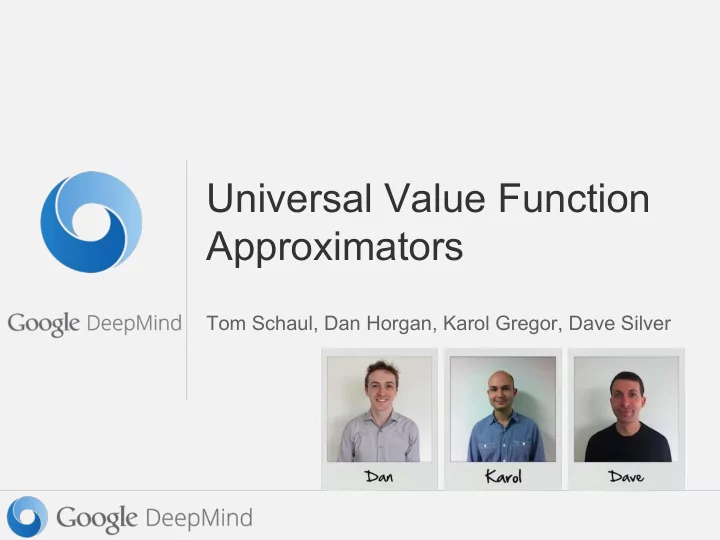

Universal Value Function Approximators Tom Schaul, Dan Horgan, Karol Gregor, Dave Silver
Motivation Forecasts about the environment • = temporally abstract predictions (questions) • not necessarily related to reward (unsupervised) • conditioned on a behavior • (aka GVFs, nexting) • many of them Why? • better, richer representations (features) • decomposition, modularity • temporally abstract planning, long horizons
Example forecasts • Hitting the wall • if the agent aims for the nearest wall • if the agent goes for the door • Remaining time on battery • if the agent stands still • if the agent keeps moving • Luminosity increase • if the agent presses the light switch • if the agent waits for sunrise
Concretely, for this work: Subgoal forecasts • Reaching any of a set of states, then • the episode terminates ( γ = 0) • and a pseudo-reward of 1 is given • Various time-horizons induced by γ • Q-values are for the optimal policy that tries to reach the subgoal (alignment) Neural networks as function approximators
Combinatorial numbers of subgoals Why? • because the environment admits tons of predictions • any of them could be useful for the task How? • efficiency • sub-linear cost in the number of subgoals • exploit shared structure in value space • generalize to similar subgoals
Outline • Motivation • learn values for forecasts • efficiently for many subgoals • Approach • new architecture • one neat trick • Results
Universal Value Function Approximator • a single neural network producing Q(s, a; g) • for many subgoals g • generalize between subgoals • compact • UVFA (“you-fah”)
UVFA architectures • Vanilla (monolithic) • Two-stream • separate embeddings φ and ψ for states and subgoals • Q-values = dot-product of embeddings • (works better)
UVFA learning • Method 1: bootstrapping • some stability issues • Method 2: • built training set of subgoal values • train with supervised objective • like neuro-fitted Q-learning • (works better)
Outline • Motivation • learn values for forecasts • efficiently for many subgoals • Approach • new architecture: UVFA • one neat trick • Results
Trick for supervised UVFA learning: FLE Stage 1: F actorize Stage 2: L earn E mbeddings +
Stage 1: Factorize (low-rank) ● target embeddings for states and goals ~ x =
Stage 2: Learn Embeddings ● regression from state/ subgoal features to target embeddings (optional Stage 3): end-to-end fine-tuning s,a
FLE vs end-to-end regression ● between 10x and 100x faster
Outline • Motivation • learn values for forecasts • efficiently for many subgoals • Approach • new architecture: UVFA • one neat trick: FLE • Results
Results: Low-rank is enough
Results: Low-rank embeddings
Results: Generalizing to new subgoals
Results: Extrapolation even to subgoals in unseen fourth room: truth UVFA
Results: Transfer to new subgoals Refining UVFA is much faster than learning from scratch
Results: Pacman pellet subgoals training set test set
Results: pellet subgoal values (test set) “truth” UVFA generalization
Summary • UVFA • compactly represent values for many subgoals • generalization, even extrapolation • transfer learning • FLE • a trick for efficiently training UVFAs • side-effect: interesting embedding spaces • scales to complex domains (Pacman from raw vision) Details: see our paper at ICML 2015
Recommend
More recommend